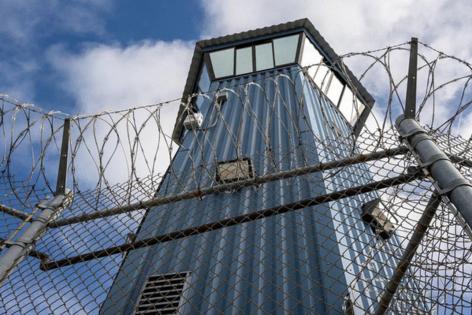California may ban forced labor in prisons. What's involuntary servitude really like?
Published in News & Features
John ‘J’ Vasquez went into prison at 16 years old and spent a decade becoming “worse inside” before he began to put in the work toward rehabilitation.
Sentenced to 15 years to life for a gang-related murder he committed as a teen, Vasquez spent more than 25 years bouncing around various California prisons before he was released on parole in 2018.
He recalls walking in to begin his sentence in the mid-1990s when a guard told him to “do yourself a favor and hang yourself.”
“During the first 10 years, I wasn’t even thinking about rehabilitation,” said Vasquez, now 47. “I was thinking about survival, about just trying to make it out without getting stabbed or killed in there.”
“I would say I became worse inside when I first got locked up,” he said. “It was a crazy environment in there.”
It wasn’t until years into his sentence, during a stint in solitary confinement, that Vasquez, whose parents struggled with drug addiction, began to evaluate his life and the things that led him to incarceration.
He had heard about a victim impact class, where crime survivors came into the prison to speak about their experiences and how crime affected them and their loved ones. Vasquez wanted to attend, but it took place during his assigned shift as a porter, performing janitorial work around a prison.
There was never enough work to keep him busy during the entire eight-hour shift, so Vasquez said he considered attending the class anyway.
“I knew, had I simply put down that broom and went to learn about the impact of my behavior, I would have been punished,” he said. For a “lifer” like him, a write-up – a mark on his prison record – could lead to a parole denial and serving years of additional time.
“Same thing with college classes, same thing with anger management, and Gang Members Anonymous. There were so many other opportunities where I wanted to work on my accountability and my rehabilitation, but I wasn’t allowed to because it conflicted with my work hours,” he said.
Vasquez, who celebrates his six-year “freedomversary” in a few weeks, said he still valued performing work in prison, though he never earned any money. It gave him something to occupy his body and mind. But he also believes the strong emphasis placed on work within the prison system delayed and “stunted” his rehabilitation.
Now employed with a restorative justice organization that works with youth in the Bay Area , Vasquez supports Proposition 6, which would outlaw involuntary servitude as punishment for a crime in California.
Labor and prison maintenance
If Prop. 6 passes, it would not mean that people in the state’s prisons and jails stop working altogether, but would make prison labor voluntary, meaning that incarcerated people who refuse an assignment could not be sanctioned with write-ups, solitary confinement, loss of visitation privileges or other punishments.
The measure has no formal opposition but some have raised concerns about how Prop. 6 would impact the day-to-day upkeep of California’s carceral facilities.
“There’s still a lot of ambiguity as to whether or not a prisoner could just simply say no to things that would be considered chores, like working in the kitchen or cleaning tasks to keep the prison sanitary,” said State Sen. Steve Glazer, D-Orinda.
Glazer said he does not support slavery, and does not think incarcerated people should “be exploited and I don’t think they should have to engage in any kind of unhealthy activities” while performing labor.
But he said those in the prison system should not be given a free pass from contributing to the cleanliness and maintenance of the places they live.
“While rehabilitation is an important component of what we would like life in prison to be about,” Glazer said, “there is a substantial cost to taxpayers for that imprisonment” – more than $132,000 per inmate per year.
Taking a gamble on education
In interviews with The Bee, other formerly incarcerated people described challenges with getting into classes and rehabilitation programs because they conflicted with assigned work schedules.
Richard Stoeckl took several punishments – including a loss of outdoor privileges and having two years’ worth of additional time tacked onto his sentence – in order to attend college classes while incarcerated.
“You got to really sacrifice everything and that’s what I did, essentially, to get into college,” said Stoekl. “I got time added on to my sentence because I chose education.”
Now a 32-year-old father who plans to graduate from California State University, Stanislaus next year, Stoeckl said he wants to get his master’s degree and continue a career as an organizer in local politics.
“I wouldn’t have been any of these things if I didn’t take a gamble on myself,” he said.
A February report by the California Department of Corrections and Rehabilitation found that people who earn educational or rehabilitative credits in prison are much less likely to commit more crimes within three years of release.
Though Yannick Ortega often had hours of free time during her shifts cleaning the prison yard or sweeping floors, she was unable to sign up for rehabilitation classes that conflicted with her work assignments.
“That is supposed to be an eight hour shift [but] you work for 15 minutes and then you have nothing else to do for the day,” Ortega said.
Instead, she would sit in the day room or go back to her cell, then check back to make sure everything was clean before her shift ended.
Eventually, she asked her case manager at the Central California Women’s Facility for a change so she could attend college courses offered at the prison.
While still incarcerated, Ortega took classes and earned certifications that helped her get a job working with patients with substance use disorder. Within four years, she was promoted to a director position at a local nonprofit in Fresno. She called her career “the most fulfilling thing that I’ve ever done in my life.”
“It’s not only allowing me to rectify my behaviors from my past, but also be able to help people get their lives back on track. To go back to their families or to their community with a healthier mindset,” she said.
Ortega said she has heard sentiments from others that incarcerated people should work as punishment for their crime. She argues that the sentence itself – the time behind bars – is the punishment.
“If we are sending people in as a punishment, then we should be giving them the opportunity to change their behavior so that when they come back out, they are a productive member of society,” she said. “If we’re not giving them anything that’s different when they’re inside, then they’re going to come back out more traumatized and 10 times worse.”
J Vasquez agreed, pointing to numbers from CDCR that show rehabilitative programs reduce recidivism.
“Probably 95% of people locked up right now will eventually become our neighbors and community members one day,” the former ‘lifer’ said. “How do we increase opportunities on the inside where people are going to turn their lives around and come home and not create more victims?”
_____
©2024 The Sacramento Bee. Visit sacbee.com. Distributed by Tribune Content Agency, LLC.







Comments